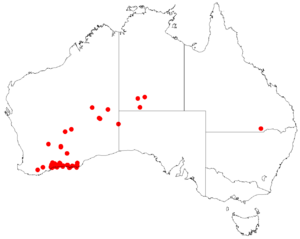Prostanthera baxteri facts for kids
Quick facts for kids Prostanthera baxteri |
|
|---|---|
| Scientific classification | |
| Genus: |
Prostanthera
|
| Species: |
baxteri
|
 |
|
| Occurrence data from AVH | |
| Synonyms | |
|
|
Prostanthera baxteri is a cool flowering plant that grows only in the south-east part of Western Australia. It's a type of shrub, which is like a bushy plant, and it's known for its pretty white flowers that sometimes have a hint of blue or light purple. It belongs to the Lamiaceae family, which is also known as the mint family!
Contents
What Does Prostanthera baxteri Look Like?
This plant is an upright shrub, meaning it grows straight up. It usually reaches about 0.3 to 1.3 meters tall, which is roughly knee-high to a bit taller than a grown-up's waist. Its stems often look white because they are covered in many tiny white hairs.
The leaves of Prostanthera baxteri are light green and shaped like narrow eggs or long, thin lines. They are usually about 5 to 15 millimeters long and 1 to 2 millimeters wide. These leaves are "sessile," which means they attach directly to the stem without a small stalk.
The flowers are quite special. Each flower grows by itself at the end of small branches or where leaves meet the stem. They sit on a tiny stalk called a "pedicel," which is about 1 to 3 millimeters long.
The green parts that protect the flower bud, called "sepals," have a bit of maroon color. They form a small tube about 2 to 4 millimeters long. The petals are white, often with a touch of blue or light purple. They are joined together to form a tube about 4.5 to 7.5 millimeters long.
The flower has two "lips." The lower lip has three parts, and the upper lip has two parts. This plant usually blooms between August and November.
How It Got Its Name
Prostanthera baxteri was first officially described in 1834. A botanist named George Bentham wrote about it in his book, using notes from another botanist, Allan Cunningham. The first samples of this plant, called "type specimens," were collected near King George Sound.
Where Does It Grow?
This mintbush loves to grow in rocky areas, especially on granite outcrops. You can also find it in sandy plains. It grows in "mallee" and "heath" communities. These are types of plant areas found in the Esperance Plains and Mallee regions in the southern part of Western Australia.
How It's Doing
Good news! The Western Australian Government's Department of Parks and Wildlife has classified Prostanthera baxteri as "not threatened." This means there are enough of these plants, and they are not currently at risk of disappearing.

